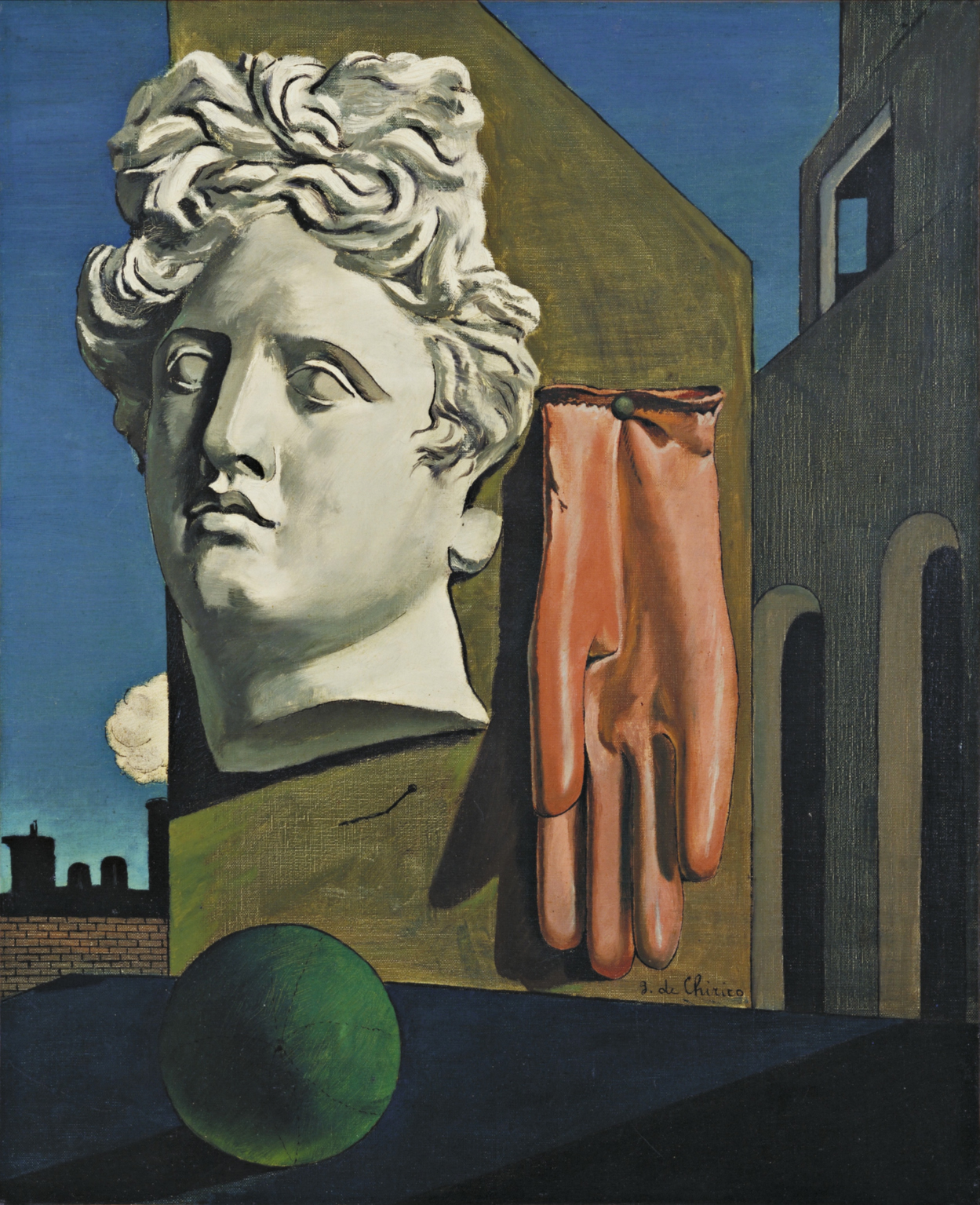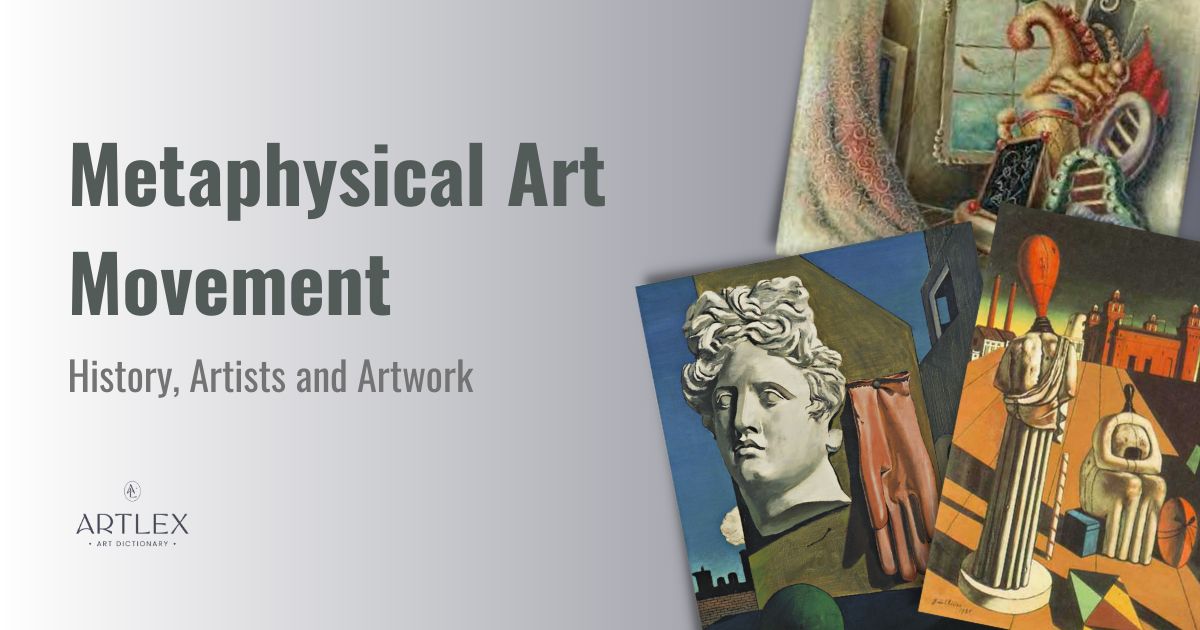What is Metaphysical Art?
Metaphysical Art (from the Italian Pittura Metafisica) is an art movement that evolved in Italy at the beginning of the 20th century. The metaphysical painting is characterized by unexpected juxtapositions of unusual elements. They create oneiric and transcendent atmospheres while maintaining a realist style. It is also characterized by intense and sharp contrasts of light and shadow, capable of communicating a feeling of disturbance, mystery, and enigma.
The painter and theorist Giorgio De Chirico was the initiator of metaphysical painting around 1910. However, metaphysical painting found its institutionalization in 1917, from the encounter of De Chirico and the former futurist painter Carlo Carra. The Metaphysical school concentrated mainly on the central Italian town of Ferrara. Besides De Chirico, other metaphysical painters were Italian artists such as Giorgio Morandi, Filippo De Pisis, and De Chirico’s younger brother, Alberto Savinio.
The Term
The term ‘metaphysical’ refers to the characteristic visionary imagery of metaphysical style. It was probably first used by the French poet Guillaume Apollinaire in an article on L’Intransigeant in 1913, to describe De Chirico’s strange paintings. However, according to other scholars, the appellative had already been used by De Chirico himself, during his stay in Paris between 1911 and 1915, to describe the works of the great painters of the past and his artworks, too.
The expression referred to the dreamlike works typical of metaphysical painting which, through unnatural deserted squares, infinite arches, and motionless characters, evoked a world beyond physical reality and contingency. A world, as the word implies, is meta-physical.
According to theorists, metaphysical painting echoes the German philosopher Arthur Schopenhauer’s theory of appearance, according to which there is another realm beyond the physical appearance of reality, beyond the experience of the senses. It can be reached through dreams and images. The authentic reality is the theoretical purpose of metaphysical painting.
Examples of Metaphysical Artworks

- https://en.wikipedia.org/wiki/File:De_Chirico%27s_Love_Song.jpg; The Song of Love, Giorgio de Chirico, 1914, Museum of Modern Art, New York. https://www.moma.org/collection/works/80419
- https://en.wikipedia.org/wiki/File:The_Disquieting_Muses.jpg; The Disquieting Muses, Giorgio de Chirico, 1947, University of Iowa Museum of Art. https://islandora.lib.uiowa.edu/islandora/object/ui%3Astanley_1968.12

- https://www.tate.org.uk/art/artworks/de-chirico-the-melancholy-of-departure-t02309; The Melancholy of Departure, Giorgio de Chirico, 1916, Tate Modern. https://www.tate.org.uk/art/artworks/de-chirico-the-melancholy-of-departure-t02309
- https://www.tate.org.uk/art/artworks/de-chirico-the-uncertainty-of-the-poet-t04109; The Uncertainty of the Poet, Giorgio de Chirico, 1913, Tate Modern.
- https://pinacotecabrera.org/collezione-online/opere/musa-metafisica/; Metaphysical Muse, Carlo Carrà, 1917, Brera Pinacoteca, Milan.
- https://pinacotecabrera.org/en/collezione-online/opere/madre-e-figlio/, Mother and Son, Carlo Carrà, 1917, Brera Pinacoteca, Milan.
- https://www.tate.org.uk/art/artworks/morandi-still-life-n05782, Still Life, Giorgio Morandi, 1946, Tate Modern.
- https://artsandculture.google.com/asset/souvenir-d-enfance-%C3%A0-ath%C3%A8nes-alberto-savinio/MwGQrMqAmwXDGg?hl=en; Souvenir d’enfance à Athènes, Alberto Savinio, 1930-31, National Gallery of Rome.
History of Metaphysical Art
Giorgio de Chirico and other Italian Artists
Metaphysical Art was born officially from the fortuitous meeting of the painter Giorgio De Chirico and the former Futurist painter Carlo Carrà in 1917 at the military hospital of Ferrara, where both were hospitalized during World War I. The two artists had already been working for some time on a new style of painting, that would surpass the earlier movement of Futurism, opposing the futurist dynamism with realist and static artworks, and its avant-garde eagerness with subjects of classical inspiration. Carrà, after the Futurist experience in his earlier work, approached Divisionist painting and in 1917 he was exploring the field of Primitivism. De Chirico and his younger brother Alberto Savinio before 1917 were already theorizing the foundational aspects of metaphysical painting.
The genesis of Metaphysical Art is in fact due to the writing of De Chirico in 1912, during his stay in Paris. The painter was describing one of his paintings of 1910, The Enigma of an Autumn Afternoon, exhibited at the Salon d’Automne. De Chirico told of the inspiration that led him to that artwork; a moment of epiphanic revelation that occurred in Piazza Santa Croce in Florence in which the artist expressly perceived the enigma of nature and the strange impression of the silent, desert square. This feeling of revelation and mystery remains present throughout the subsequent De Chirico’s work. In 1914 also Carlo Carrà and writers and poets Ardengo Soffici and Giovanni Papini arrived in Paris. On that occasion, they knew De Chirico and Savinio. However, at the outbreak of World War I, artists had to enlist in the army.
It was necessary to wait for the meeting of De Chirico and Carrà to officially movement began. After the encounter, Carrà exhibited at the Paolo Chini Gallery of Milan a personal exhibition of his works, in which there were artworks strongly inspired by the metaphysical style. Giorgio De Chirico, who was practically unknown at the time, had to wait until 1919 when he exhibited his paintings for the first time in Italy at the Galleria Anton Giulio Bragaglia in Rome. The dispute between Carrà and De Chirico over the invention of Metaphysical Art was very heated at the time. To this day, studies consider De Chirico to be the greatest exponent of the movement.
Typical Features of Metaphysical Painting
Metaphysical Art is characterized by extreme realism and precision of execution and, at the same time, from an atmosphere that goes beyond reality. This is what confers the mysterious quality of metaphysical paintings. They are ‘landscapes of the mind’.
There are some pictorial devices typical of De Chirico’s paintings, such as unnaturally sharp contrasts, deep perspectival space, and dark-toned sky. Also contributing to the sense of enigma were the titles the painter chose for his artworks, such as Enigma of an Autumn Afternoon, the Philosopher’s Conquest, Soothsayer’s recompense, or the painting Turin Melancholy.
Recurrent iconographic elements in the metaphysical paintings are deserted city squares of Italian cities, use of mannequins, Greek statues and other mythological and classical elements, architectural structures with arches, all arousing a sense of loneliness and displacement.
However, different metaphysical painters declined the style with different emphases. De Chirico searched for the enigma, juxtaposing objects and using, according to the art historian Jennifer Mundy, a great sense of irony and playfulness. The theme of the fantastic, the game, the imaginary was very present in the compositions of his brother Savinio. Carrà was attracted by Metaphysical Art mainly for the search for pure formal values, without deep descriptiveness. For Giorgio Morandi, the metaphysical style was a way of purifying the subject, focusing on the meaning of objects.
Metaphysical Art Legacy
Metaphysical painting influenced the art movement of Surrealism, for the affinity of themes and similar ideas and artistic intentions. In particular, the compositions of Max Ernst were largely influenced by the metaphysical school. It was a major influence also for René Magritte, Salvador Dalì, and French avant-garde theorist André Breton. In terms of references, the metaphysical painters also inspired in the 1920s the German paintings of George Grosz and Oscar Schlemmer, who used the iconic aesthetic of mannequins. De Chirico’s paintings, for their vaguely threatening mystery also influenced later the style of the Italian painter Felice Casorati.
Notable Metaphysical Artists
- Giorgio de Chirico (10 July 1888 – 20 November 1978), Italian
- Alberto Savinio (25 August 1891 – 5 May 1952), Italian
- Giorgio Morandi (July 20, 1890 – June 18, 1964), Italian
- Carlo Carrà (February 11, 1881 – April 13, 1966), Italian
- Filippo De Pisis (11 May 1896 – 2 April 1956), Italian
- Mario Sironi (May 12, 1885 – August 13, 1961), Italian
Related Terms
- Surrealism
- Futurism
- Symbolism
- Primitivism
- Dadaism
- Cubism
- Neoclassicism
- Magic Realism
- Plastic Values

